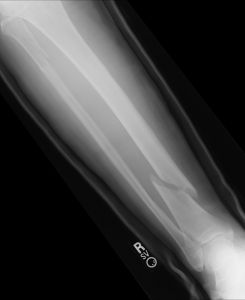What is knee arthroscopy?
During the last two decades, the diagnosis and treatment of knee joint problems have improved thanks to a minimally invasive procedure called knee arthroscopy. This surgical technique allows orthopedic specialists to see inside the knee and to carry out diagnostic and treatment measures through tiny incisions. This approach to surgery reduces pain, minimizes scarring, and helps speed up the recovery period when compared to traditional “open” knee surgery.
How does arthroscopy of the knee work?
Arthroscopy involves the orthopedic surgeon to using a device known as an arthroscope. This instrument is a tiny, pen-shaped device that has a small video camera attached to the end. The arthroscope is inserted into the knee through small incisions and the camera relays images to a computer screen. Our orthopedic specialists can use these images to diagnose knee problems. Once that is done, the doctor can carry out the appropriate procedure in the same surgical setting.
What does knee arthroscopic surgery treat?
Orthopedic specialists can use arthroscopic surgery to perform a variety of procedures. These include the repair or reconstruction of torn ligaments, the removal of small loose bits of bone. The hard tissue that provides structural support to the body. It is primarily composed of hydroxyapatite cryst… or cartilagecartilageThe hard, thin layer of white glossy tissue that covers the end of bone at a joint. This tissue allows motion, and repair or resection of torn meniscus tissue. Many of these conditions arise due to a knee injury or degeneration.
What are the benefits of arthroscopic surgery of the knee?
There are many benefits of knee arthroscopy when compared to traditional “open” surgery. With this procedure, you likely to experience less pain after the surgery and you have a lower risk of developing certain complications like infections or scarring. In addition, the hospital stay is shorter as most knee arthroscopic surgeries are performed on an outpatient basis in a freestanding surgery center. The greatest benefit is usually a quicker overall recovery.
What are the risks of knee arthroscopy?
All medical and surgical procedures have some risk. With knee arthroscopy, the risks are minimal and our orthopedic specialist will discuss these with you prior to your surgery. These risks depend on your current state of health, the type of surgery performed, and the extent of your injury or knee problem.
What should I expect before surgery?
Prior to an arthroscopic procedure, depending on your overall health you might have to see a primary care health professional for a general physical examination. In addition, you will need to tell the doctor about any medications you are taking and he may advise you to stop some of these before the procedure.
What should I expect after surgery?
You will need to start exercising the knee immediately after your procedure to restore range of motion and strength to the joint. While many patients get back to normal activities without much difficulty, plan to discuss this issue with your orthopedic specialist, as he may have a specific rehabilitation program for you to follow.
Immediately after your knee arthroscopy you will experience some swelling and discomfort of the knee. This will usually only last for a few days, however. Your doctor will prescribe specific medications that work to alleviate these symptoms and help you get back on your feet.
Also, you should expect to feel a little stiff when performing exercises early after surgery. Any activity that leads to significant discomfort should be stopped immediately and your orthopedic specialist should be notified. Our orthopedic surgeons request that you elevate your leg frequently and use ice to reduce swelling.
 A fracture is a broken bone and when a bone is fractured, it is broken. A bone may be completely fractured or partially fractured in many different ways. It could break cross-wise, length-wise, or in the middle.
A fracture is a broken bone and when a bone is fractured, it is broken. A bone may be completely fractured or partially fractured in many different ways. It could break cross-wise, length-wise, or in the middle.
 A hand fracture happens when one or more of the small bones of the hand are broken. The hand is composed of several small bones that come together to make up the hand’s supporting framework. Most fractures of the hand occur as a direct result of trauma to the hand. If the hand strikes an object, is struck by an object, or an object falls onto the hand, a fracture can occur. Hand fractures can occur in the long bones of the hand, known as the metacarpals, or they can occur in the small bones of the fingers, known as the phalanges.
A hand fracture happens when one or more of the small bones of the hand are broken. The hand is composed of several small bones that come together to make up the hand’s supporting framework. Most fractures of the hand occur as a direct result of trauma to the hand. If the hand strikes an object, is struck by an object, or an object falls onto the hand, a fracture can occur. Hand fractures can occur in the long bones of the hand, known as the metacarpals, or they can occur in the small bones of the fingers, known as the phalanges.